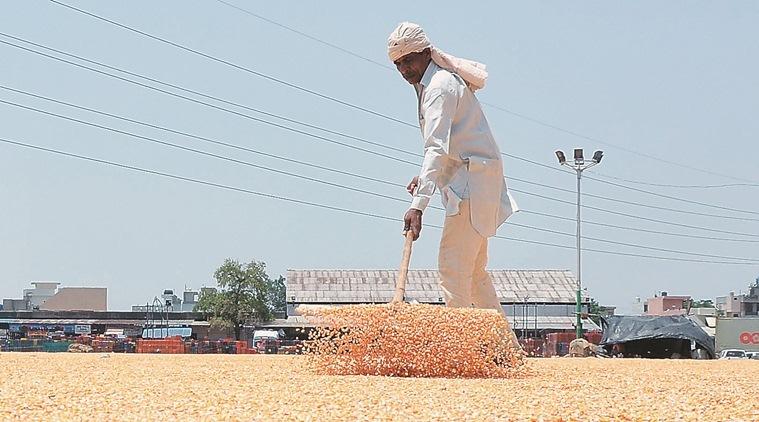Kharif Sowing Falls as 374 Districts Face Rainfall Deficit

While Prime Minister Narendra Modi has been busy with tiger counts in the promotional run-up to his appearance on a TV reality show, and his ministers were preoccupied with the Kargil anniversary and the Karnataka imbroglio, here is a snapshot of what is going on in the forgotten paddy fields of the country. It is kharif sowing time – paddy; arhar (tur), urad, moong; jowar bajra, ragi; groundnut, soyabean, sunflower; sugarcane; and cotton, jute is planted in this season. It is really a crunch time for kharif farmers spread across the country. And, most of them depend on good monsoon rains to sustain their precious crops.
But the news on monsoon rainfall this year is not so good till now. The onset was delayed but there is leeway for farmers as they can slightly adjust the sowing in kharif. What is worrying is that halfway through the season, rainfall deficit is reported by the India Meteorological Department (IMD) in as many as 374 districts spread across 16 states till July 24, 2019. That’s 55% of the country’s districts.
Of these, 322 (47%) districts have reported ‘deficient’ rainfall while 52 (8%) have reported ‘largely deficient’ rainfall. According to IMD terminology, ‘deficient’ means 20% to 59% less than normal while ‘largely deficient’ means a shortfall of 60% to 99%. ‘Normal’ is defined as the 30-year moving average.
On the other side, 80 districts (12%) have reported excess or largely excess rainfall till now. That’s not good for the crops too. In fact, massive floods have engulfed the eastern parts of India, especially Bihar and West Bengal. In all, some 222 districts of the country (only 33% of all districts) are reporting ‘normal’ rainfall.
Remember: there has been deficient rainfall in some or the other part of the country for the past five years at least. Last year, 39% of districts had deficient rainfall. Some important regions – important from the kharif output point of view – are facing a deficit for the second year running. These are Rayalseema region in Andhra Pradesh where last year there was a deficit of 12% which has ticked up to 22% this year; Chhattisgarh, down from 17% deficit to 28%; Eastern Madhya Pradesh, from barely normal last year to 25% deficit this year, and Himachal Pradesh where deficit has gone from 17% last year to 43% this year.
Farmers Are Desperate
So, what’s the impact of this on farmers? No rains (or less rains) means farmers will delay sowing of crops. They have to wait and see whether rains are sufficient, otherwise their hard work and all the expenses on preparing the fields, getting seeds, etc. will go waste.
According to the Crop Situation Report put out every month by the agriculture ministry, paddy sowing is down by about 12.6 lakh hectares over last year for the corresponding period (last week of July). Since last year itself was a rain- deficient year, how does present sowing compare with ‘normal’ sowing, computed as an average of past three years? Paddy sowing is down by a whopping 30.6 lakh hectares.
In the case of sowing area of other kharif crops, pulses are down by over 9 lakh hectares, coarse cereals by over 16 lakh hectares, oilseeds by nearly nine lakh hectares. Sugarcane sowing is up by about 5 lakh hectares while cotton is up by over 6 lakh hectares. These last two crops show improved sowing because the areas where they are grown – Western UP, Gujarat and Maharashtra – have received good rainfall till now. All this is compared to normal sowing for the corresponding period.
To some extent, the gap between current and normal sowing can be bridged if there is sufficient rainfall in the deficient areas in the coming couple of weeks. After that the window will close. Even if you plant paddy or other crops after that, the yields will be affected.
What this shortfall will mean is that farmers will be faced with low production output. Since they are in any case not getting remunerative prices for their produce, low output means an intensification of their financial crisis – more debt, more deprivation.
To give a sense of the crisis caused by low returns, have a look at last year’s kharif prices. Out of 118 days of kharif produce marketing season (October to January) prices were below the declared Minimum Support Price (MSP) for paddy in over 90% of days in West Bengal, Uttar Pradesh and Chhattisgarh, while such days were 64% in Telangana and 71% in Tamil Nadu. In Punjab only one day prices fell below the MSP. In Andhra Pradesh, prices of paddy fell below MSP only in 18% days.
Remember that only a fraction of the farmers’ output goes to the market (marketable surplus). And, if in most cases they don’t get even the MSP – which is barely covering the cost of production – then they are forced into debt and poverty. This has been happening every year because the Modi government has refused to increase MSPs of various produce to 50% more than the total cost of production (called C2), as recommended by the MS Swaminathan Commission.
So, this year, the farmers are again likely to face a deficit in their earnings sparked off by deficient rains, adding to their already unbearable debt burdens. They await a new vision from Modi 2.0 government.
Get the latest reports & analysis with people's perspective on Protests, movements & deep analytical videos, discussions of the current affairs in your Telegram app. Subscribe to NewsClick's Telegram channel & get Real-Time updates on stories, as they get published on our website.
























